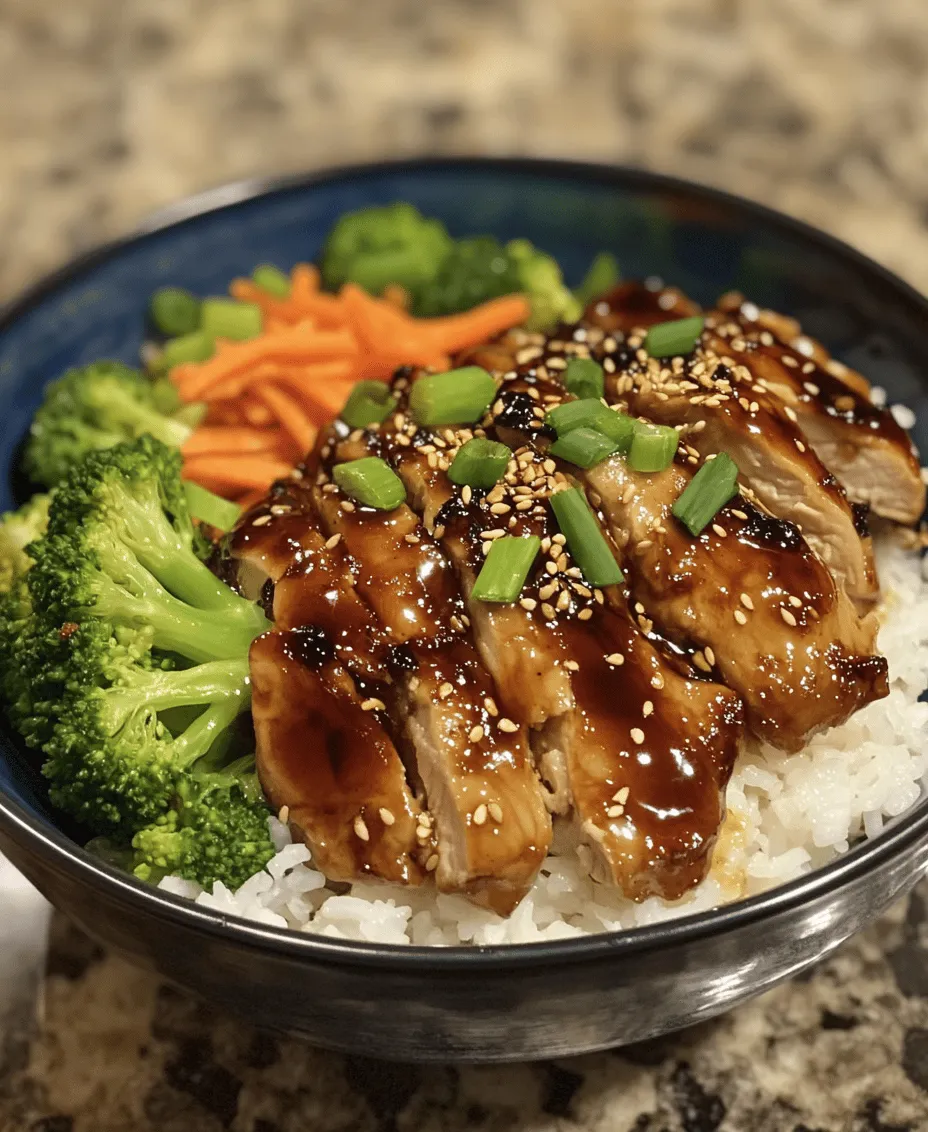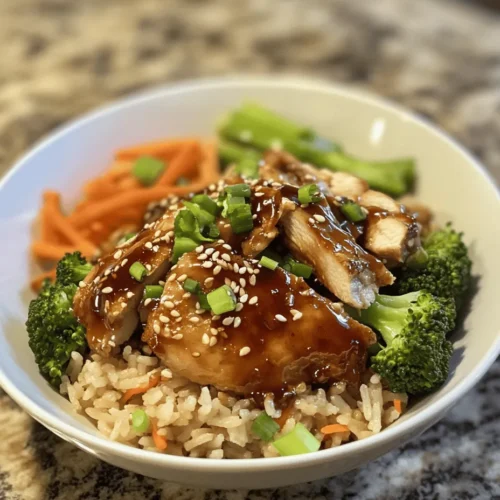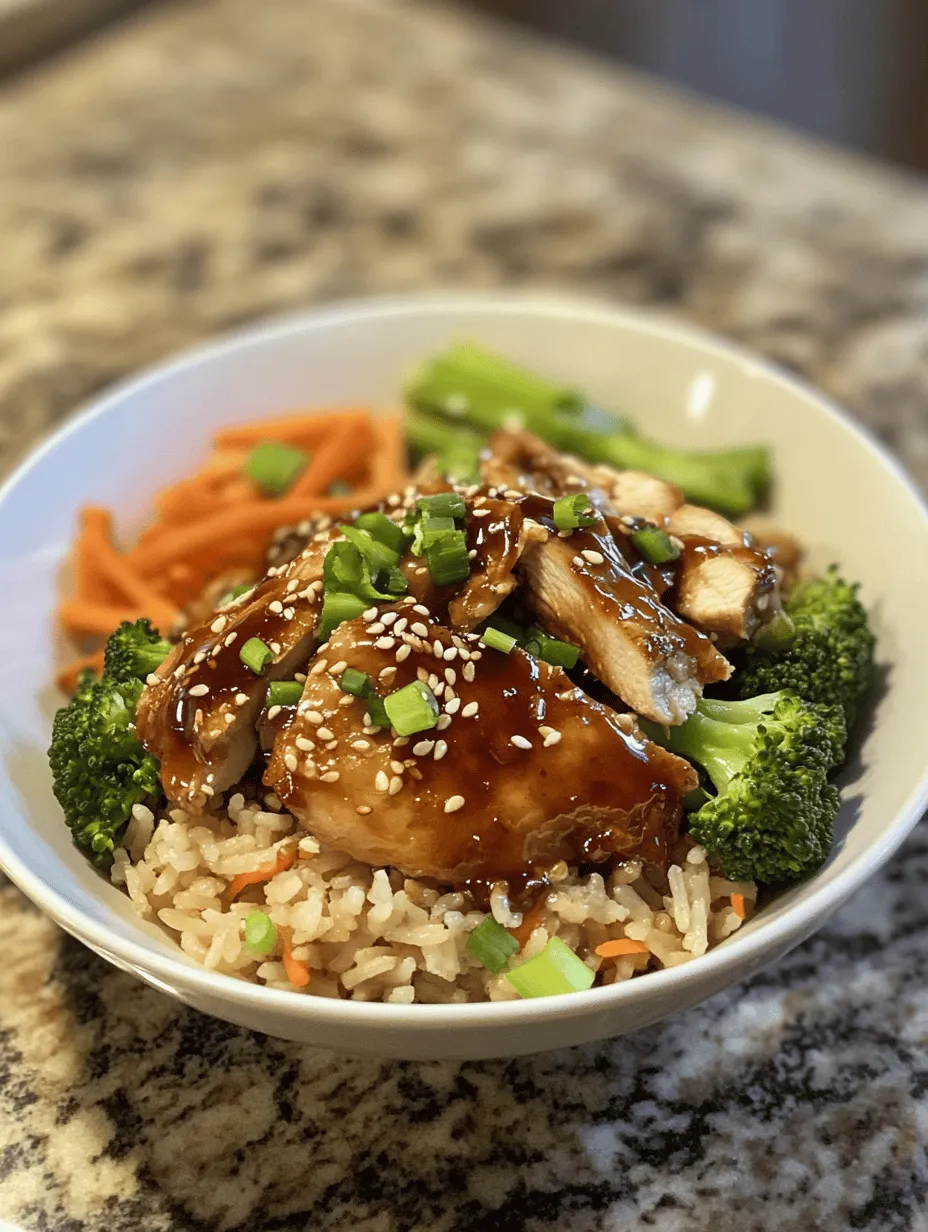Introduction
The Teriyaki Chicken Rice Bowl is a beloved staple in Japanese cuisine, celebrated for its delightful combination of savory, sweet, and umami flavors. This dish features tender chicken glazed in a rich teriyaki sauce, served over a bed of fluffy rice, and often accompanied by colorful vegetables. Its popularity has spread far beyond Japan, making it a favorite choice for home cooks and restaurant diners alike.
One of the main appeals of the Teriyaki Chicken Rice Bowl is its robust flavor profile. The harmonious blend of soy sauce, mirin, and honey creates a glossy glaze that envelops the chicken, offering a delectable balance of sweetness and saltiness. Moreover, the dish is not just about great taste; it also boasts numerous health benefits. Chicken thighs provide a rich source of protein, while the accompanying vegetables add essential vitamins and minerals.
Versatility is another hallmark of the Teriyaki Chicken Rice Bowl. It is suitable for various occasions, whether you’re whipping up a quick weeknight dinner, meal prepping for a busy week ahead, or impressing guests with a delightful homemade dish. With its combination of flavors and textures, this bowl is sure to please palates of all ages.
Understanding Teriyaki Cuisine
To truly appreciate the Teriyaki Chicken Rice Bowl, it’s essential to understand what teriyaki means and its significance in Japanese cooking. The term “teriyaki” refers to a cooking method that involves grilling or broiling food while basting it with a sweet soy sauce marinade. The word itself is derived from “teri,” which means “luster” or “glaze,” and “yaki,” which means “grilled” or “broiled.” This technique not only enhances the flavor of the ingredients but also gives them a beautiful glossy finish that is visually appealing.
Common ingredients used in teriyaki dishes include soy sauce, mirin, sake, and sugar, which together create the rich, sweet-savory sauce that teriyaki is known for. Each of these components plays a crucial role in building flavor. For instance, soy sauce provides the umami depth, while mirin and sugar contribute sweetness that balances the saltiness. Additionally, teriyaki is often paired with various vegetables, enhancing the dish’s nutritional profile and providing a vibrant contrast in color.
Ingredients Breakdown
Boneless, Skinless Chicken Thighs
When preparing a Teriyaki Chicken Rice Bowl, the choice of protein is vital. Boneless, skinless chicken thighs are often preferred over chicken breasts for their higher fat content, which results in a juicier and more flavorful dish. The thighs remain tender during cooking and absorb the teriyaki sauce beautifully, making every bite incredibly satisfying. Moreover, chicken thighs tend to be more forgiving in terms of cooking time, reducing the risk of drying out.
Japanese Short-Grain Rice
Rice is the foundation of any rice bowl dish, and in this case, Japanese short-grain rice is the star. This type of rice is known for its sticky texture and slightly sweet flavor, which is essential for holding together the ingredients in the bowl. The short grains clump together when cooked, creating a satisfying base that complements the chicken and sauce. The preparation of this rice is crucial; it should be rinsed thoroughly before cooking to remove excess starch and ensure the perfect texture.
Soy Sauce
Soy sauce is a cornerstone of teriyaki flavor. It acts as a seasoning and a marinade, infusing the chicken with umami richness. For those concerned about sodium intake, low-sodium soy sauce is an excellent alternative that still delivers authentic flavor without overwhelming saltiness. It is important to choose a good quality soy sauce for the best results, as it can significantly influence the overall taste of the dish.
Mirin
Mirin is a sweet rice wine that plays a pivotal role in the teriyaki sauce. It adds a unique sweetness and depth, balancing the saltiness of soy sauce. Mirin helps to create that coveted glaze on the chicken and adds complexity to the flavor profile. It is worth noting that there are various types of mirin available, including hon-mirin (true mirin) and aji-mirin (mirin-style seasoning), with the former being the preferred choice for authentic dishes.
Honey vs. Brown Sugar
When it comes to sweetening the teriyaki sauce, you can choose between honey and brown sugar, each offering distinct flavor profiles. Honey brings a floral sweetness and a hint of acidity, while brown sugar contributes a deeper, molasses-like flavor. The choice between the two often comes down to personal preference and dietary considerations, as honey is a natural sweetener while brown sugar offers a bit of extra moisture.
Rice Vinegar
Rice vinegar is an essential ingredient in balancing the flavors of the teriyaki sauce. Its mild acidity cuts through the richness of the soy sauce and sweetness of the mirin and honey, creating a well-rounded flavor. Additionally, rice vinegar can enhance the overall freshness of the dish, making it more enjoyable.
Garlic and Ginger
Garlic and ginger are aromatics that elevate the marinade, adding depth and complexity to the flavor profile. Both ingredients come with their own health benefits: garlic is known for its immune-boosting properties, while ginger aids digestion and has anti-inflammatory effects. Together, they create a fragrant base that enhances the flavor of the chicken.
Sesame Oil
A drizzle of sesame oil adds a nutty richness to the dish. This oil is extracted from toasted sesame seeds, giving it a distinctive flavor that complements the teriyaki sauce beautifully. In addition to enhancing taste, sesame oil is rich in healthy fats and antioxidants, making it a nutritious choice in cooking.
Vegetables
For added nutrition and color, consider incorporating vegetables such as broccoli and carrots into your Teriyaki Chicken Rice Bowl. Broccoli is packed with vitamins C and K, while carrots are a great source of beta-carotene. These vegetables not only contribute to the dish’s visual appeal but also add essential nutrients, making the meal more balanced.
Optional Garnishes
To finish off your Teriyaki Chicken Rice Bowl, consider garnishing it with sliced green onions and sesame seeds. Green onions add a fresh, mild onion flavor that brightens the dish, while sesame seeds provide a delightful crunch and enhance the nutty aroma of the sesame oil. These garnishes not only contribute to the dish’s aesthetic but also elevate the overall flavor experience.
Preparation Steps for Teriyaki Chicken Rice Bowl
Now that we have explored the key ingredients that make up the Teriyaki Chicken Rice Bowl, let’s delve into the preparation process. Each step is designed to ensure optimal flavor and texture, allowing you to create a dish that is both delicious and visually appealing.
1. Prepare the Marinade: Start by combining soy sauce, mirin, honey (or brown sugar), garlic, ginger, and rice vinegar in a mixing bowl. Whisk the ingredients until well blended to create a flavorful marinade.
2. Marinate the Chicken: Place the boneless, skinless chicken thighs in a resealable plastic bag or a shallow dish. Pour the marinade over the chicken, ensuring that it is evenly coated. Seal the bag or cover the dish, and refrigerate for at least 30 minutes. For maximum flavor, consider marinating the chicken for up to 2 hours.
3. Cook the Rice: While the chicken is marinating, prepare the Japanese short-grain rice. Rinse the rice under cold water until the water runs clear to remove excess starch. Transfer the rinsed rice to a rice cooker or a pot, add the appropriate amount of water (usually a 1:1 ratio), and cook according to the rice cooker instructions or bring to a boil, then reduce to a simmer and cover for approximately 18-20 minutes.
4. Cook the Chicken: After marinating, remove the chicken from the refrigerator. Heat a skillet or grill pan over medium-high heat and add a splash of sesame oil. Once hot, remove the chicken from the marinade, allowing excess marinade to drip off, and place it in the pan. Cook for about 5-7 minutes on each side, or until the chicken is cooked through and caramelized on the outside. Use any remaining marinade to baste the chicken during cooking for added flavor.
5. Prepare the Vegetables: While the chicken is cooking, steam or sauté the broccoli and carrots until tender but still vibrant in color. This usually takes about 5-7 minutes. You can add a splash of water to the pan to help steam the veggies, or use a steamer basket.
In the next part of this article, we will explore the finishing touches to your Teriyaki Chicken Rice Bowl and provide tips to ensure your dish is a showstopper at the dinner table. Stay tuned!

Ideal Marinating Times for Maximum Flavor Development
To truly elevate the flavors of your Teriyaki Chicken Rice Bowl, marinating the chicken is crucial. For optimal flavor absorption, aim to marinate the chicken thighs for at least 30 minutes, although 2 to 4 hours in the refrigerator is ideal. If you’re planning ahead, marinating overnight will yield even deeper flavors. Just ensure that you don’t exceed 24 hours, as the acid in the marinade can start to break down the chicken too much, resulting in a mushy texture. To enhance the marinating process, consider using a zip-top bag to ensure every piece of chicken is coated evenly with the marinade.
Cooking the Rice Perfectly
Techniques for Rinsing Rice and the Significance of Removing Excess Starch
Rinsing rice is an essential step in achieving the ideal texture for your Teriyaki Chicken Rice Bowl. By rinsing your rice under cold water, you remove excess starch that can make the rice gummy. This process also allows the grains to separate during cooking, ensuring each bite is fluffy and light.
Step-by-Step Guide on Cooking Rice to Achieve the Perfect Texture
1. Measure and Rinse: Start by measuring out your rice—typically, 1 cup of rice will serve about 2-3 people. Place the rice in a fine-mesh strainer and rinse it under cold water until the water runs clear, which usually takes about 1-2 minutes.
2. Soak (Optional): For even better texture, soak the rinsed rice in water for 30 minutes before cooking. This step is optional but can lead to softer grains.
3. Cook: Add the rinsed (and soaked, if applicable) rice to a pot along with 1.5 cups of water and a pinch of salt. Bring to a boil over medium-high heat. Once boiling, reduce the heat to low and cover. Let it simmer for 15-20 minutes without lifting the lid.
4. Fluff: After the cooking time, remove the pot from heat and let it sit, covered, for an additional 5-10 minutes. Finally, fluff the rice with a fork to separate the grains before serving.
Cooking the Chicken to Perfection
Tips on Cooking Chicken Thighs for Juiciness and Flavor
For the best results, use boneless, skinless chicken thighs in this recipe. They are more forgiving than chicken breasts, as they retain moisture better and have a richer flavor. When cooking, aim for a high heat to achieve a nice sear on the outside, which locks in juices.
1. Preheat your skillet: Heat a tablespoon of oil in a large skillet over medium-high heat until shimmering.
2. Cook the Chicken: Add the marinated chicken thighs to the skillet in a single layer. Avoid overcrowding the pan—cook in batches if necessary. Sear for about 6-7 minutes per side, or until the internal temperature reaches 165°F (75°C).
3. Rest the Chicken: Once cooked, transfer the chicken to a cutting board and let it rest for at least 5 minutes. Resting allows the juices to redistribute throughout the meat, ensuring every bite is tender and flavorful.
Creating the Teriyaki Sauce
Step-by-Step Guide for Making the Sauce
Making a homemade teriyaki sauce is straightforward and far superior to store-bought versions. Here’s how to do it:
1. Ingredients: In a saucepan, combine 1/2 cup soy sauce, 1/4 cup mirin, 2 tablespoons brown sugar, and 1 tablespoon rice vinegar.
2. Simmer: Bring the mixture to a simmer over medium heat, stirring to dissolve the sugar.
3. Thicken: In a small bowl, mix 1 tablespoon of cornstarch with 2 tablespoons of cold water to create a slurry. Gradually add this slurry to the simmering sauce, stirring constantly until it thickens, which should take about 1-2 minutes.
4. Flavors: Taste and adjust the seasoning if necessary. You might want to add more sugar for sweetness or soy sauce for saltiness.
Importance of Simmering the Sauce to Enhance Flavors
Simmering allows the ingredients to meld together, creating a deeper, more complex flavor profile. The longer you simmer (without reducing it too much), the more pronounced the flavors will be.
Blanching the Vegetables
Explanation of Blanching and Its Benefits
Blanching is a cooking technique that involves briefly boiling vegetables and then plunging them into ice water to halt the cooking process. This method helps retain the vibrant colors, crisp texture, and nutritional value of your vegetables.
Step-by-Step Instructions for Properly Blanching Broccoli and Carrots
1. Prepare the Vegetables: Cut broccoli into bite-sized florets and slice the carrots into thin matchsticks or rounds for even cooking.
2. Boil Water: Bring a large pot of salted water to a rolling boil.
3. Blanch: Add the broccoli and carrots to the boiling water for 2-3 minutes. The vegetables should be bright in color and just tender.
4. Ice Bath: Immediately transfer the blanched vegetables to a bowl of ice water. This will stop the cooking process, maintaining their crunch and color.
5. Drain and Dry: Once cooled, drain the vegetables and gently pat them dry with a clean towel.
Assembling the Teriyaki Chicken Rice Bowl
Visual Appeal: Layering Ingredients for the Best Presentation
The presentation of your Teriyaki Chicken Rice Bowl is key to making it visually appealing. Start by placing a generous scoop of fluffy rice at the bottom of a bowl.
1. Add the Chicken: Slice the rested chicken thighs into strips and arrange them artfully on top of the rice.
2. Layer the Vegetables: Next, neatly arrange the blanched broccoli and carrots around the chicken. This not only adds color but also creates an inviting look.
3. Drizzle with Sauce: Generously drizzle the homemade teriyaki sauce over the chicken and vegetables.
Importance of Fluffing Rice and Techniques for Serving
Fluffing the rice before serving ensures that each grain is separated, preventing a clumpy texture. Use a fork to gently fluff the rice, and serve it in the bowl with the other ingredients arranged on top.
Garnishing for Flavor and Presentation
Discussing the Role of Garnishes in Enhancing Flavor and Visual Appeal
Garnishing your dish elevates its overall flavor and presentation. Fresh herbs or crunchy toppings can provide a burst of freshness and texture.
Suggestions for Alternative Garnishes to Personalize the Dish
– Sesame Seeds: Toasted sesame seeds add a nutty flavor and a lovely crunch.
– Green Onions: Thinly sliced green onions bring a fresh, sharp contrast to the rich teriyaki flavor.
– Cilantro: Fresh cilantro can add an aromatic touch, though it’s best for those who enjoy its distinctive flavor.
– Red Pepper Flakes: For a hint of heat, sprinkle some red pepper flakes over the top.
Nutritional Information
Overview of the Nutritional Benefits of the Teriyaki Chicken Rice Bowl
This Teriyaki Chicken Rice Bowl is not just delicious; it’s also a well-balanced meal. Chicken thighs provide a good source of protein, while the vegetables contribute vitamins, minerals, and fiber. Brown rice can be used as a healthier alternative, offering more fiber and nutrients than white rice.
Discussion on Portion Sizes and Balanced Meal Considerations
A typical serving of this dish includes about 4-6 ounces of chicken, a cup of rice, and a generous portion of vegetables. This combination ensures that you’re getting a good balance of macronutrients—proteins, carbohydrates, and healthy fats—along with essential vitamins and minerals.
Conclusion
In summary, the Teriyaki Chicken Rice Bowl is a delightful blend of flavors, textures, and colors, making it a satisfying meal for any occasion. With its rich teriyaki sauce, juicy chicken, and vibrant vegetables, this recipe is not only easy to prepare but also offers a wealth of nutritional benefits.
We encourage you to try making this dish at home and to experiment with different ingredients and garnishes to tailor it to your personal taste. Whether you stick to the classic recipe or create your own variations, this Teriyaki Chicken Rice Bowl is sure to become a family favorite. Enjoy the process of cooking and the delicious results that follow!



